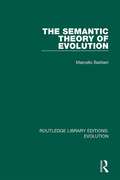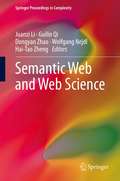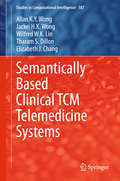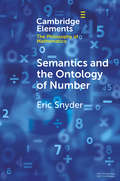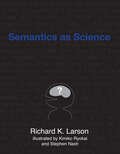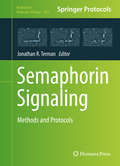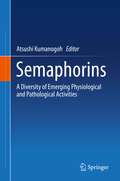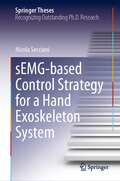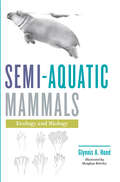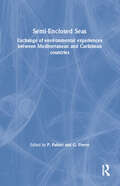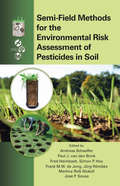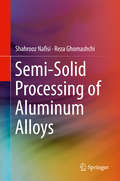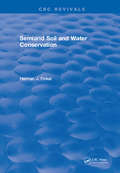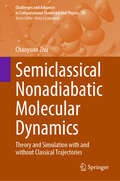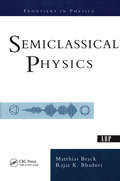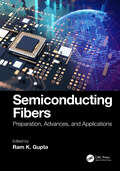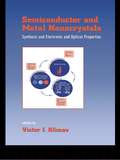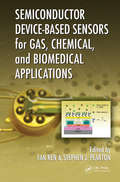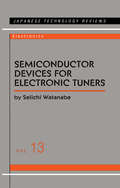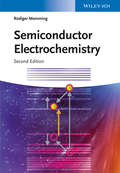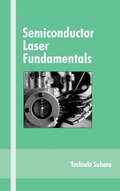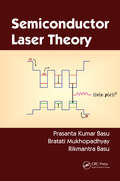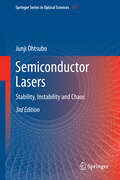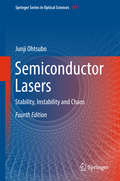- Table View
- List View
The Semantic Theory of Evolution (Routledge Library Editions: Evolution #1)
by Marcello BarbieriOriginally published in 1985, The Semantic Theory of Evolution addresses the notion that life is not shaped by the single law of natural selection, but instead by a plurality of laws that resemble grammatical rules in language. This remarkable work presents a semantic theory centering on the concept of the ribotype. Supported by both sound facts and logical arguments, this analysis reaches beyond the established cadre of biological thought to unravel many of life’s mysteries and paradoxes, including the origin of the cell and the nucleus and the evolution of ribosomes.
Semantic Web and Web Science
by Wolfgang Nejdl Dongyan Zhao Guilin Qi Hai-Tao Zheng Juanzi LiThe book will focus on exploiting state of the art research in semantic web and web science. The rapidly evolving world-wide-web has led to revolutionary changes in the whole of society. The research and development of the semantic web covers a number of global standards of the web and cutting edge technologies, such as: linked data, social semantic web, semantic web search, smart data integration, semantic web mining and web scale computing. These proceedings are from the 6th Chinese Semantics Web Symposium.
Semantically Based Clinical TCM Telemedicine Systems
by Allan K. Y. Wong Jackei H. K. Wong Wilfred W. K. Lin Tharam S. Dillon Elizabeth J. ChangRecent years have seen the development of two significant trends namely: the adoption of some Traditional Chinese Medicine Practices into mainstream Allopathic Western Medicine and the advent of the internet and broad band networks leading to an increased interest in the use of Telemedicine to deliver medical services. In this book, we see the convergence of these two trends leading to a semantically-based TCM Telemedicine system that utilizes an ontology to provide sharable knowledge in the TCM realm to achieve this. The underpinning research required the development of a three-layer architecture and an Ontology of the TCM knowledge. As TCM knowledge like all medical knowledge is not frozen in time it was important to develop an approach that would allow evolution of the Ontology when new evidence became available. In order for the system to be practically grounded it was important to work with an industry partner PuraPharm Group/HerbMiners Informatics Limited. This partnership was initiated through Professor Allan Wong and the Chairman of PuraPharm Group Mr. Abraham Chan. This led to the system being utilized in more than 20 Mobile Clinics in Hong Kong and 300 Hospitals in China. In order for these different deployments of the system to be coherent with the main core Ontology, it was necessary for us to develop an Ontology Driven Software System Generation approach.
Semantics and the Ontology of Number (Elements in the Philosophy of Mathematics)
by Eric SnyderWhat are the meanings of number expressions, and what can they tell us about questions of central importance to the philosophy of mathematics, specifically 'Do numbers exist?' This Element attempts to shed light on this question by outlining a recent debate between substantivalists and adjectivalists regarding the semantic function of number words in numerical statements. After highlighting their motivations and challenges, I develop a comprehensive polymorphic semantics for number expressions. I argue that accounting for the numerous meanings and how they are related leads to a strengthened argument for realism, one which renders familiar forms of nominalism highly implausible.
Semantics as Science
by Richard K. LarsonAn introductory linguistics textbook that takes a novel approach: studying linguistic semantics as an exercise in scientific theory construction.This introductory linguistics text takes a novel approach, one that offers educational value to both linguistics majors and nonmajors. Aiming to help students not only grasp the fundamentals of the subject but also engage with broad intellectual issues and develop general intellectual skills, Semantics as Science studies linguistic semantics as an exercise in scientific theory construction. Semantics offers an excellent medium through which to acquaint students with the notion of a formal, axiomatic system—that is, a system that derives results from a precisely articulated set of assumptions according to a precisely articulated set of rules. The book develops semantic theory through the device of axiomatic T-theories, first proposed by Alfred Tarski more than eighty years ago, introducing technical elaboration only when required. It adopts Japanese as its core object of study, allowing students to explore and investigate the real empirical issues arising in the context of non-English structures, a non-English lexicon and non-English meanings. The book is structured as a laboratory science text that poses specific empirical questions, with 25 short units, each of which can be covered in one class session. The layout is engagingly visual, designed to help students understand and retain the material, with lively illustrations, examples, and quotations from famous scholars.
Semaphorin Signaling
by Jonathan R. TermanThis volume arranged into three sections describes biochemical, in vitro, and in vivo protocols on Semaphorins. Chapters focus on approaches that would allow the novice to study Semaphorins and employ robust assays to characterize mechanisms of action. Written in the highly successful Methods in Molecular Biology series format, chapters include introductions to their respective topics, lists of the necessary materials and reagents, step-by-step, readily reproducible laboratory protocols, and tips on troubleshooting and avoiding known pitfalls. Authoritative and cutting-edge, Semaphorin Signaling: Methods and Protocols aims to ensure successful results in the further study of this vital field.
Semaphorins
by Atsushi KumanogohThis book presents the current concepts of semaphorin biology. In the early 1990s, semaphorins were originally identified as axon guidance cues that function during neuronal development. However, cumulative findings have clarified that they have diverse functions in many physiological processes, including cardiogenesis, angiogenesis, vasculogenesis, osteoclastogenesis, retinal homeostasis, and immune regulation. Additionally, they have been implicated in the pathogenesis of various human diseases, including tumorigenesis/tumor metastasis, neuroregenerative diseases, retinal degeneration, irregular pulse/sudden death, and immune disorders. Based on this current research background, the book covers the essential state-of-the-art findings for basic scientists in biochemistry, molecular biology, neuroscience, developmental biology, and structural biology, as well as for physicians in neurology, cardiology, oncology, orthopedic surgery, otorhinolaryngology, ophthalmology, allergology, and rheumatology.
sEMG-based Control Strategy for a Hand Exoskeleton System (Springer Theses)
by Nicola SeccianiThis book reports on the design and testing of an sEMG-based control strategy for a fully-wearable low-cost hand exoskeleton. It describes in detail the modifications carried out to the electronics of a previous prototype, covering in turn the implementation of an innovative sEMG classifier for predicting the wearer's motor intention and driving the exoskeleton accordingly. While similar classifier have been widely used for motor intention prediction, their application to wearable device control has been neglected so far. Thus, this book fills a gap in the literature providing readers with extensive information and a source of inspiration for the future design and control of medical and assistive devices.
Semi-aquatic Mammals: Ecology and Biology
by Glynnis A. HoodSemi-aquatic mammals are some of the rarest and most endangered mammals on earth. What binds them together in the minds of biologists, despite their diverse taxa and body forms, are evolutionary traits that allow them to succeed in two worlds—spending some time on land and some in the water. Semi-aquatic Mammals fills a crucial void in the literature by highlighting the important ecological roles and curious biology of these remarkable animals.In this unique book, wildlife ecologist Glynnis A. Hood presents the first comprehensive examination of a global suite of 140 freshwater semi-aquatic mammals. Each one has overcome the distinct ecological challenges of thriving in both aquatic and terrestrial habitats as part of everyday life. Covering millions of years, Hood's exploration begins with the extinct otter-like Buxolestes and extends to consider the geographical, physical, behavioral, and reproductive traits of its present-day counterparts. Hood explains how semi-aquatic mammals are able to navigate a viscous environment with almost no resistance to heat loss, reveals how they maintain the physical skills necessary to avoid predation and counter a more thermally changeable environment, and describes the array of adaptations that facilitate success in their multifaceted habitats. She also addresses specific conservation challenges faced by these mammals.Her analysis takes readers to the haunts of intriguing semi-aquatic mammals from around the world,• introducing the "paradoxical platypus," an Australian egg-laying monotreme that detects prey through electroreception• venturing into the swamps and mangroves of Southeast Asia, where fishing cats wave their paws above the water's surface to lure prey• trawling the streams and lakes of South America, where the female water opossum uses its backward-facing pouch to keep her babies warm during deep dives• spending time with species that engineer freshwater habitats into more productive and complex systems, including North American beavers and Africa's common hippopotamusFeaturing award-winning artist Meaghan Brierley's stunning illustrations throughout, Semi-aquatic Mammals is an unparalleled reference on some of the world's most tenacious and fascinating mammals.
Semi-Enclosed Seas: Exchange of environmental experiences between Mediterranean and Caribbean countries
by Paolo Fabbri Giuliano FierroProceedings of the International Meeting on UNEP's Regional Programmes in Mediterranean and Caribbean Seas, Genoa, Italy, 12-14 February 1992 which concentrated on three issues of particular interest: water quality, coastal zone management, sea-level rise and the risks and consequences of erosion and flooding.
Semi-Field Methods for the Environmental Risk Assessment of Pesticides in Soil
by Andreas Schaeffer Paul J. van den Brink Fred Heimbach Simon P. Hoy Frank M.W. de Jong Jörg Römbke Martina Roß-Nickoll José P. SousaBased on discussions at the 2007 SETAC Europe PERAS Workshop in Coimbra, Semi-Field Methods for the Environmental Risk Assessment of Pesticides in Soil presents a timely summary of state-of-the-art higher-tier terrestrial risk assessment of plant protection products (PPPs). Influential regulators, academics, and industry scientists provide a compre
Semi-Solid Processing of Aluminum Alloys
by Shahrooz Nafisi Reza GhomashchiThis book describes in great detail the semi-solid processing of aluminum alloys. The authors examine the fundamentals of semi-solid metal processing, provide guidelines for research, illustrate the tools that are employed, and explain the measured parameters for semi-solid processing characterization.
Semiarid Soil and Water Conservation
by FinkelIn this volume, the erosion and conservation measures discussed are, for the most part, those under unirrigated agriculture. The use of irrigation could cause significant changes in the growing seasons, and in the agricultural calendar, especially in the warmer climates where temperature is not a limiting factor. It is further noted that much of the material in this volume has been prepared with the developing countries of the so-called Third World in mind. In many of these countries there is a dearth of basic data, such as long-term hydrological records, detailed soil and topographic surveys, and experimental results for various types of erosion control measures. Some design procedures cannot be imitated or copied directly from those of the technologically more advanced countries. Consequently, emphasis will be placed, wherever possible, upon simple empirical methods of design, and approximate solutions within the limitations of the available data, technical possibilities, and financial resources of the Third World countries. Much of the numerical data and calculations will be presented in the metric system.
Semiclassical Nonadiabatic Molecular Dynamics: Theory and Simulation with and without Classical Trajectories (Challenges and Advances in Computational Chemistry and Physics #38)
by Chaoyuan ZhuThis book shows how to derive the simple and accurate semiclassical methods analytically and its applications to excited-state molecular dynamics and spectroscopy simulation with and without classical trajectories. It consists of eight chapters demonstrating interesting conical and intersystem-driven photochemical processes in complex systems targeting on large-scale ab initio direct nonadiabatic molecular dynamics. It also includes two chapters dealing with time-independent and time-dependent nonadiabatic molecular dynamics and clarifies the underline principle of Born–Oppenheimer approximation associated with coherence/decoherence quantum effects that have a wide range of applications in photochemistry and photophysics. This book is interesting and useful to a wide readership in the various fields of basic quantum chemistry and physics associated with large-scale excited-state simulation of nonadiabatic molecular dynamics and spectroscopy.
Semiclassical Physics (Frontiers in Physics)
by Matthias BrackSemiclassical Physics explores the fascinating and deep connection between classical motion and quantum fluctuations. The book conveys a way of describing quantum effects in a physical system using the periodic orbit theory of Gutzwiller, which focuses on the classical dynamics of the system. The authors seek to demonstrate its usefulness for understanding quantum fluctuations in interacting many-body systems, exhibiting the close link of the shorter classical periodic orbits with the partly resolved shell fluctuations. The extended Thomas-Fermi model is developed in detail and shown to describe the average properties of finite fermion systems in a self-consistent mean-field approach. The new, updated paperback edition includes: Basic introduction to semiclassical physics for the general reader Elementary derivation of the Gutzwiller trace formula for chaotic systems; thorough discussion of its extensions to mixed and integrable systems, uniform approximations, and diffractive corrections Unified presentation of extended Thomas-Fermi model, Wigner-Kirkwood expansion, Weyl and Euler-MacLaurin expansions, and Strutinsky averaging Relations of the Gutzwiller theory to the Selberg trace formula and Bogomolny's transfer-matrix method Applications to finite fermion systems in nuclear, atomic and condensed matter physics Analytical examples and educational problems with hints to their solution Appendices to facilitate further detailed study The book addresses graduate students with a basic knowledge of classical and quantum mechanics and scientists with an interest in semiclassical methods. The approach is informal, guided largely by simple solvable models and by practical applications to real physical phenomena.
Semiconducting Fibers: Preparation, Advances, and Applications
by Ram K GuptaSemiconducting Fibers: Preparation, Advances, and Applications is a comprehensive study of the properties and emerging applications of semiconducting fibers. These nanomaterials have unique optoelectronic properties: they are flexible, one-dimensional, and lightweight, and can grow in bulk, thin films, and nano-dimensions (0D, 1D, 2D, 3D). Written by experts from around the world, this book covers the fundamentals of semiconducting fibers, their fabrication, and emerging applications in electronics, optoelectronics, energy, and healthcare. Various approaches to fabricating semiconducting fibers, their characteristics, and the working principles of nano-dimensional devices are covered.Key features:• Expert scientists across the world present state-of-the-art progress on semiconducting fibers for emerging applications, including flexible and wearable electronics. • Provides details of novel methods and advanced technologies used in energy applications of semiconducting fibers.• Provides fundamentals of electrochemical behavior and their understanding of optoelectronics, photovoltaics, batteries, fuel cells, sensors, and supercapacitors.• Presents fabrication, characterization, and applications of semiconducting fibers for energy conversion and storage.This book will be a key resource for students, academics, and industry professionals interested in the fabrication, device technologies, and applications of semiconducting fibers.
Semiconducting Metal Oxides for Gas Sensing
by Yonghui DengThe second edition of this book focuses on the synthesis, design, and application of semiconducting metal oxides as gas sensing materials, including the gas sensing mechanism, and modification methods for sensing materials, while also providing a comprehensive introduction to semiconductor gas sensing devices. As an essential part of IoT (Internet of things), gas sensors have shown great significance and promising prospects. Therefore, studies on functional mesoporous metal oxides, one of the most important gas sensing materials based on their unique Knudsen diffusion behavior and tailored pore structure, have increasingly attracted attention from various disciplines. The book offers a valuable reference guide to metal oxide gas sensing materials for undergraduate and graduate students alike. It will also benefit all researchers who are involved in synthesis and gas sensing of metal oxides nanomaterials with relevant frontier theories and concepts. Engineers working on research and development of semiconductor gas sensors will also find some new ideas for sensor design.
Semiconductor and Metal Nanocrystals: Synthesis and Electronic and Optical Properties (Optical Science And Engineering Ser.)
by Victor I. KlimovThe vast technological potential of nanocrystalline materials, as well as current intense interest in the physics and chemistry of nanoscale phenomena, has led to explosive growth in research on semiconductor nanocrystals, also known as nanocrystal quantum dots, and metal nanoparticles. Semiconductor and Metal Nanocrystals addresses current topics impacting the field including synthesis and assembly of nanocrystals, theory and spectroscopy of interband and intraband optical transitions, single-nanocrystal optical and tunneling spectroscopies, electrical transport in nanocrystal assemblies, and physical and engineering aspects of nanocrystal-based devices. Written by experts who have contributed pioneering research, this reference comprises key advances in the field of semiconductor nanocrystal quantum dots and metal nanoparticles over the past several years. Focusing specifically on nanocrystals generated through chemical techniques, Semiconductor and Metal Nanocrystals Merges investigative frontiers in physics, chemistry, and engineeringDocuments advances in nanocrystal synthesis and assemblyExplores the theory of electronic excitations in nanoscale particlesPresents comprehensive information on optical spectroscopy of interband and intraband optical transitionsReviews data on single-nanocrystal optical and tunneling spectroscopiesWeighs controversies related to carrier relaxation dynamics in ultrasmall nanoparticlesDiscusses charge carrier transport in nanocrystal assemblies Provides examples of lasing and photovoltaic nanocrystal-based devices Semiconductor and Metal Nanocrystals is a must read for scientists, engineers, and upper-level undergraduate and graduate students interested in the physics and chemistry of nanoscale semiconductor and metal particles, as well as general nanoscale science.
Semiconductor Device-Based Sensors for Gas, Chemical, and Biomedical Applications
by Stephen J. Pearton Fan RenThis book provides a basic understanding of new developments on semiconductor-based sensors. Written for senior undergraduate and graduate students majoring in solid-state physics, electrical engineering, and materials science and engineering, this material is also relevant to researchers in the field of sensors for gas, chemical, bio, and medical applications. It presents original theory and experimental research, featuring numerous experts in the field who review progress in semiconductor and nano-material-based sensors and discuss the latest research regarding their applications. Fields addressed include: Si-MOS based sensors, nano-material based sensors, GaN-bsed sensor arrays for nano- and pico-fluidic systems, and InN based sensors.
Semiconductor Devices for Electronic Tuners (Japanese Technology Reviews Ser. #Sec. A)
by Seiichi WatanabeThis tract describes in detail the semiconductor components of the high-frequency front end-the electronic tuner-of televisions and VCRs. These high-frequency components substantially determine performance, including clarity of reception, and thus their quality is crucial to the success of electronic tuners. The semiconductor devices involved-voltage-variable capacitance diodes, band-switch diodes, dual-gate FETs, and others-are discussed in this book, as is their performance as mediators of tuning and amplification. Special emphasis is put on the analysis of distortion characteristics of tuning diodes and FETs, which are essential in providing tuners with high endurance against interfering signals. Design and fabrication processes well suited for mass production are also described. The content will be most informative not only to those involved in R&D and production of semiconductor devices, but also to high-frequency systems designers.
Semiconductor Electrochemistry
by Rüdiger MemmingProviding both an introduction and an up-to-date survey of the entire field, this text captivates the reader with its clear style and inspiring, yet solid presentation. <P><P>The significantly expanded second edition of this milestone work is supplemented by a completely new chapter on the hot topic of nanoparticles and includes the latest insights into the deposition of dye layers on semiconductor electrodes. <P>In his monograph, the acknowledged expert Professor Memming primarily addresses physical and electrochemists, but materials scientists, physicists, and engineers dealing with semiconductor technology and its applications will also benefit greatly from the contents.
Semiconductor Laser Fundamentals (Optical Science and Engineering)
by Toshiaki SuharaRanging from fundamental theoretical concepts to advanced device technologies, this reference/text explores the engineering, characteristics, and performance of specific semiconductor lasers. It defines key principles in electromagnetics, optoelectronics, and laser implementation for novel applications in optical communications, storage, processing
Semiconductor Laser Theory
by Prasanta Kumar Basu Bratati Mukhopadhyay Rikmantra BasuDeveloped from the authors' classroom-tested material, Semiconductor Laser Theory takes a semiclassical approach to teaching the principles, structure, and applications of semiconductor lasers. Designed for graduate students in physics, electrical engineering, and materials science, the text covers many recent developments, including diode lasers u
Semiconductor Lasers
by Junji OhtsuboThis third edition of "Semiconductor Lasers, Stability, Instability and Chaos" was significantly extended. In the previous edition, the dynamics and characteristics of chaos in semiconductor lasers after the introduction of the fundamental theory of laser chaos and chaotic dynamics induced by self-optical feedback and optical injection was discussed. Semiconductor lasers with new device structures, such as vertical-cavity surface-emitting lasers and broad-area semiconductor lasers, are interesting devices from the viewpoint of chaotic dynamics since they essentially involve chaotic dynamics even in their free-running oscillations. These topics are also treated with respect to the new developments in the current edition. Also the control of such instabilities and chaos control are critical issues for applications. Another interesting and important issue of semiconductor laser chaos in this third edition is chaos synchronization between two lasers and the application to optical secure communication. One of the new topics in this edition is fast physical number generation using chaotic semiconductor lasers for secure communication and development of chaos chips and their application. As other new important topics, the recent advance of new semiconductor laser structures is presented, such as quantum-dot semiconductor lasers, quantum-cascade semiconductor lasers, vertical-cavity surface-emitting lasers and physical random number generation with application to quantum key distribution. Stabilities, instabilities, and control of quantum-dot semiconductor lasers and quantum-cascade lasers are important topics in this field.
Semiconductor Lasers
by Junji OhtsuboThis third edition of "Semiconductor Lasers, Stability, Instability and Chaos" was significantly extended. In the previous edition, the dynamics and characteristics of chaos in semiconductor lasers after the introduction of the fundamental theory of laser chaos and chaotic dynamics induced by self-optical feedback and optical injection was discussed. Semiconductor lasers with new device structures, such as vertical-cavity surface-emitting lasers and broad-area semiconductor lasers, are interesting devices from the viewpoint of chaotic dynamics since they essentially involve chaotic dynamics even in their free-running oscillations. These topics are also treated with respect to the new developments in the current edition. Also the control of such instabilities and chaos control are critical issues for applications. Another interesting and important issue of semiconductor laser chaos in this third edition is chaos synchronization between two lasers and the application to optical secure communication. One of the new topics in this edition is fast physical number generation using chaotic semiconductor lasers for secure communication and development of chaos chips and their application. As other new important topics, the recent advance of new semiconductor laser structures is presented, such as quantum-dot semiconductor lasers, quantum-cascade semiconductor lasers, vertical-cavity surface-emitting lasers and physical random number generation with application to quantum key distribution. Stabilities, instabilities, and control of quantum-dot semiconductor lasers and quantum-cascade lasers are important topics in this field.
